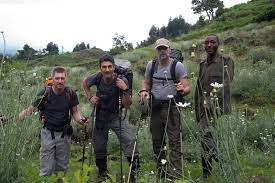Hiking & Climbing experience
Hiking & Climbing experience, Hiking and climbing are great outdoor activities that offer an opportunity to explore nature and challenge yourself physically. Here are some things to keep in mind when planning a hiking or climbing trip:
Choose a destination: Research different hiking and climbing destinations. And choose one that fits your interests and skill level. Consider factors such as distance, elevation gain, and terrain difficulty.
Check the weather: Check the weather forecast for the area you plan to visit and plan accordingly. Bring appropriate clothing and gear for the conditions.
Plan your route: Plan your hiking or climbing route in advance and make sure to bring a map, compass, or GPS device to help you navigate. Let someone know your planned route and estimated return time in case of emergency.
Bring the right gear: Bring appropriate gear for your activity. Such as hiking boots, climbing harnesses, helmets, and other protective gear. Bring plenty of water and snacks to stay hydrated and energized.
Follow Leave No Trace principles: Follow Leave No Trace principles to minimize your impact on the environment. This includes packing out all trash, staying on designated trails, and avoiding damage to vegetation and wildlife.
Be prepared for emergencies: Bring a first aid kit and know basic first aid skills. Know the location of the nearest hospital or emergency services in case of an emergency.
Respect local customs and regulations: Be aware of local customs and regulations, such as permits or restricted areas. Respect the natural environment and cultural heritage of the area.
Remember to always prioritize safety and respect for the environment when planning and undertaking hiking or climbing trips.
Types Hiking Safaris
Hiking safaris are a popular way to explore the beauty of nature and wildlife in different parts of the world. Here are some types of hiking safaris:
Mountain hiking safaris: Mountain hiking safaris involve hiking up mountains and exploring the beauty of nature at high elevations. Some popular mountain hiking safari destinations include Mount Kilimanjaro in Tanzania, the Himalayas in Nepal. And the Rocky Mountains in the United States.
Desert hiking safaris: Desert hiking safaris involve exploring the beauty of the desert landscape on foot. Some popular desert hiking safari destinations include the Sahara Desert in North Africa, the Namib Desert in Namibia, and the Atacama Desert in Chile.
Jungle hiking safaris: Jungle hiking safaris involve hiking through dense jungle forests to observe wildlife and explore the beauty of nature. Some popular jungle hiking safari destinations. Include the Amazon Rainforest in Brazil, the Bwindi Impenetrable Forest in Uganda, and the Daintree Rainforest in Australia.
Coastal hiking safaris: Coastal hiking safaris involve hiking along coastal areas. Often with views of the ocean and marine life. Some popular coastal hiking safari destinations. Include the Amalfi Coast in Italy, the Great Ocean Road in Australia, and the Oregon Coast in the United States.
Cultural hiking safaris: Cultural hiking safaris involve hiking through areas with significant cultural heritage and learning about the local people and their traditions. Some popular cultural hiking safari destinations include the Inca Trail in Peru, the Camino de Santiago in Spain, and the Annapurna Circuit in Nepal.
Hiking safaris can be customized to fit your interests and skill level, and can range from short day hikes to multi-day expeditions.
Types Hiking Safaris in Uganda
Uganda is a great destination for hiking safaris, with a variety of options for exploring the beauty of nature and wildlife. Here are some types of hiking safaris you can experience in Uganda:
Gorilla tracking: Gorilla tracking involves hiking through dense forest to observe endangered mountain gorillas in their natural habitat. Uganda is home to over half of the world’s population of mountain gorillas. Making it an ideal destination for this type of hiking safari. Bwindi Impenetrable Forest National Park and Mgahinga Gorilla National Park are popular destinations for gorilla tracking.
Rwenzori Mountains trekking: The Rwenzori Mountains in western Uganda offer a challenging and rewarding trekking experience. The range is known for its stunning peaks and glaciers.And is home to a variety of wildlife such as chimpanzees, colobus monkeys, and hyrax. Treks can range from one to several days, depending on your skill level and interests.
Hiking in Kibale Forest National Park: Kibale Forest National Park is known for its diverse flora and fauna, including over 350 species of birds and 13 species of primates, including chimpanzees. Hiking trails in the Park Range from easy to moderate, and can be tailored to fit your interests and skill level.
Mount Elgon trekking: Mount Elgon, located on the border of Uganda and Kenya, offers a less crowded alternative to other popular hiking destinations. The mountain is home to a variety of wildlife, including elephants, buffalo, and primates, and features stunning waterfalls and hot springs. Treks to the summit can take several days and require a moderate level of fitness.

Sipi Falls trekking: Sipi Falls is a popular destination for hiking and trekking in eastern Uganda. The area features stunning waterfalls and scenic views of the countryside. And treks can range from short day hikes to longer multi-day expeditions.
These are just a few examples of the types of hiking safaris you can experience in Uganda. Each offers a unique and rewarding way to explore the beauty of nature and wildlife in this stunning African country.
Packing for a hiking and walking safari in Uganda
When packing for a hiking and walking safari in Uganda, it’s important to consider the climate and terrain of the region you’ll be visiting. As well as the length and type of safari you’ll be undertaking. Here are some essential items to consider bringing:
Hiking boots: Comfortable and sturdy hiking boots are essential for any hiking or walking safari. Look for boots that provide good ankle support and are appropriate for the terrain you’ll be hiking on.
Lightweight clothing: Uganda can be hot and humid, so it’s important to pack lightweight and breathable clothing that can wick away sweat. Quick-drying fabrics are also a good option in case of rain or water crossings.
Rain gear: Uganda experiences rainfall throughout the year, so it’s important to bring a waterproof jacket and pants to keep you dry in case of a downpour
Hiking & Climbing experience, Sun protection: Sunscreen, a hat, and sunglasses are important to protect your skin and eyes from the sun’s harmful rays.
Insect repellent: Uganda is home to a variety of insects, including mosquitoes that can carry diseases like malaria. Be sure to bring insect repellent with DEET or other effective ingredients to keep bugs at bay.
Water bottle: Staying hydrated is important on any hiking or walking safari. Bring a reusable water bottle that you can refill throughout the day.
First aid kit: A small first aid kit with basic supplies like band-aids, pain relievers, and antiseptic can come in handy for any minor injuries or ailments.
Camera: Uganda offers some amazing wildlife and scenic views. So be sure to bring a camera to capture your memories.
Binoculars: Binoculars can help you get a closer look at wildlife and birds, especially those in the distance.
Daypack: A small backpack or daypack is useful for carrying water, snacks. And other essentials while on a hike or walking safari.
Hiking & Climbing experience , Remember to pack light and only bring what you need to avoid over packing and making your safari more difficult.
